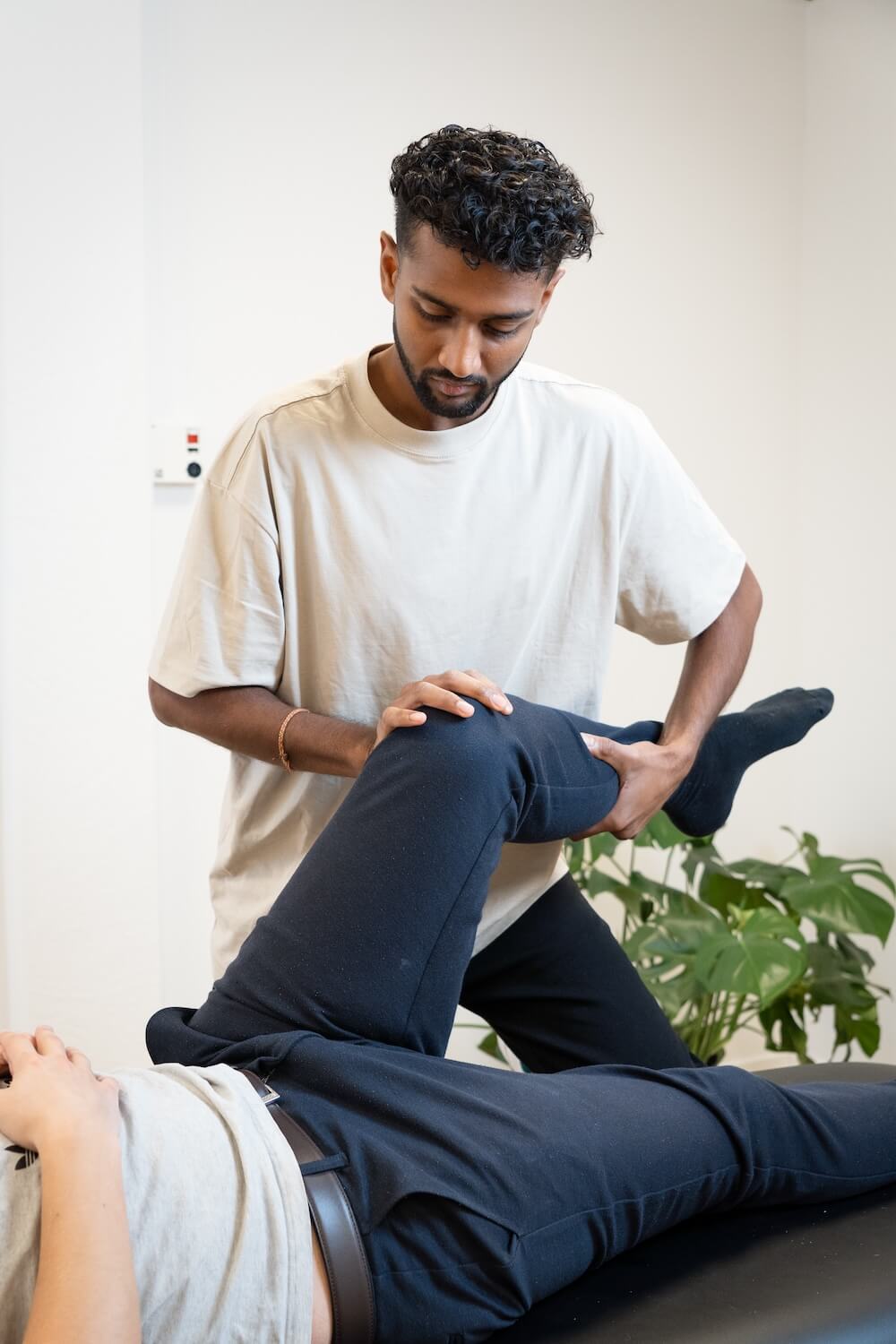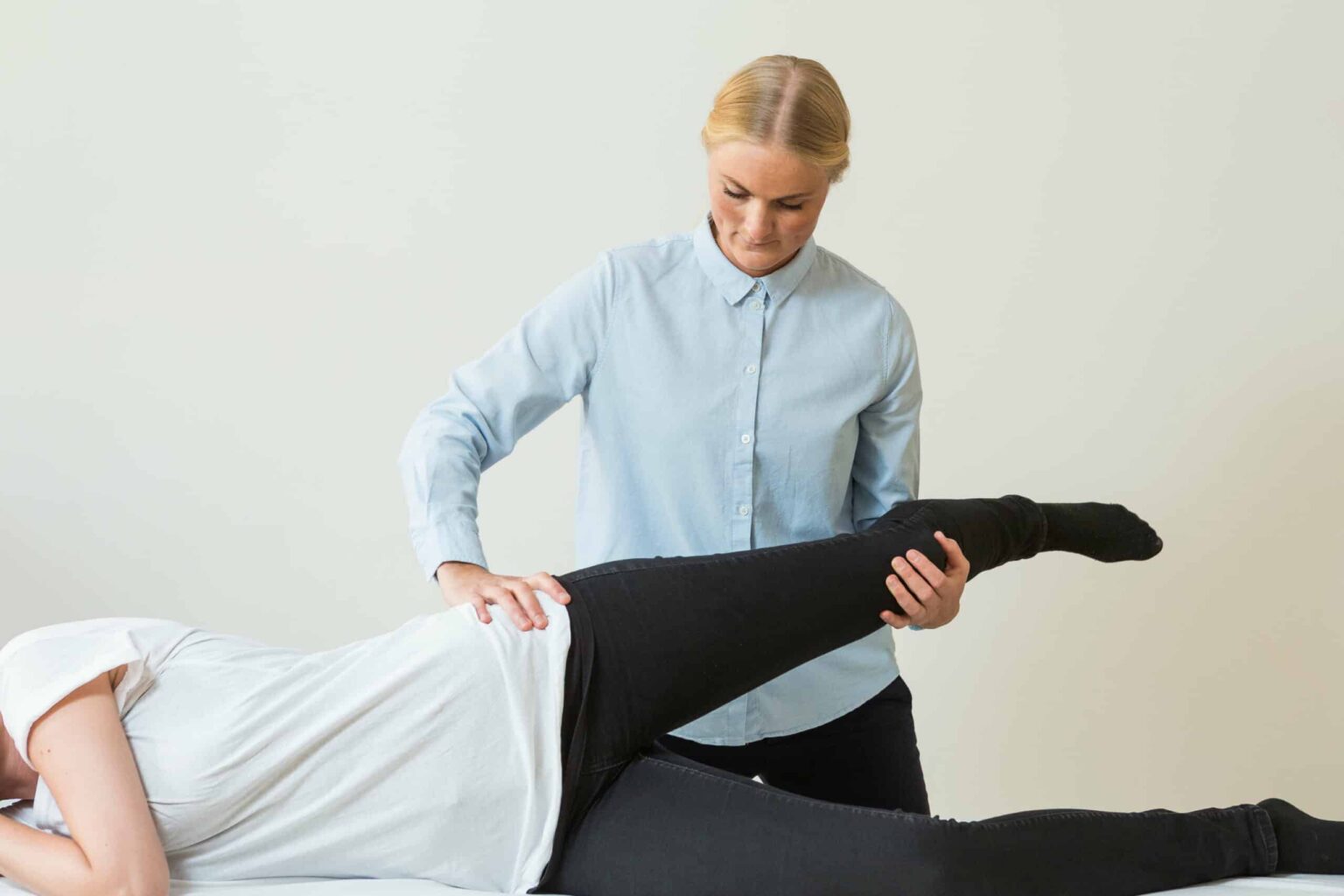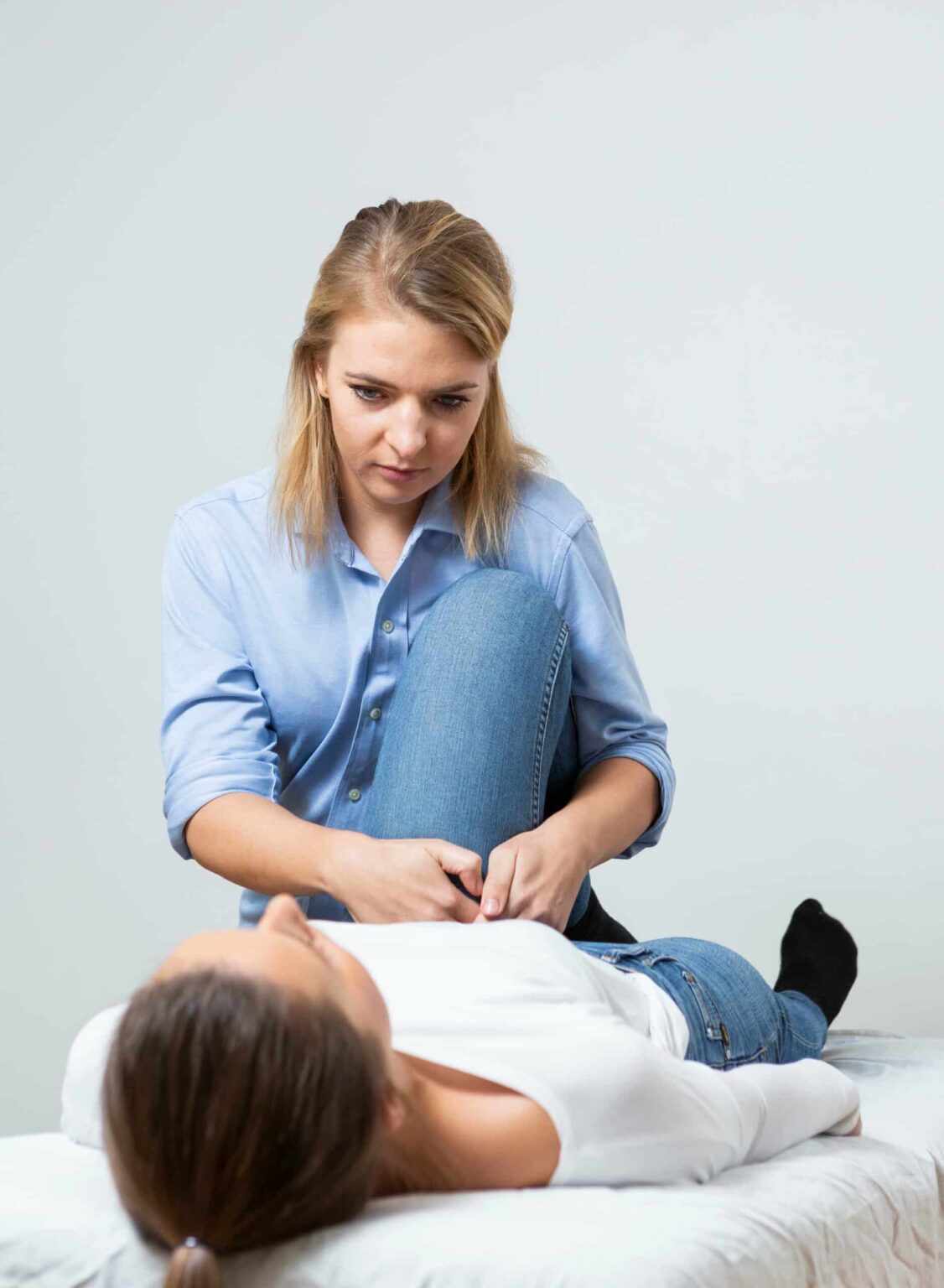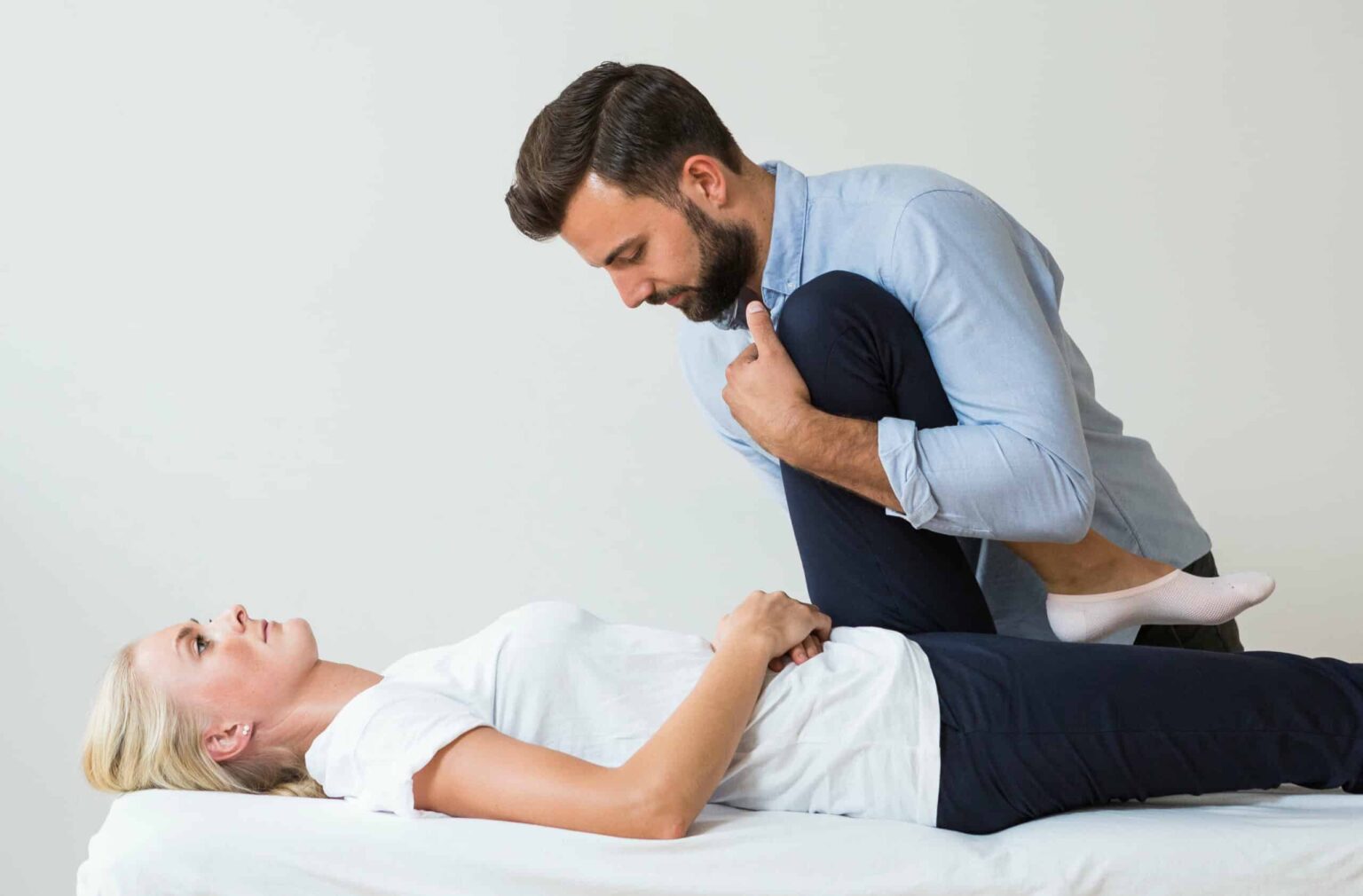We treat
Bursitis of the hip
Learn more about trochanter bursitis
What does a mucus sac look like?
A mucus sac, also known as a bursa, is a small fluid-filled cushion that acts as a sliding surface between tendons, muscles, and bones in the body. Bursae are found in various parts of the body and help reduce friction and facilitate movement.
Jump to section [Vis]
Symptoms of trochanter bursitis
Symptoms of trochanteric bursitis, also known as hip bursitis, can vary from person to person.
Some common symptoms include:
- Pain on the outside of the hip: The most common symptom is pain on the outside of the hip or femoral crest. The pain can be localized and can extend from the hip down towards the thigh or even the knee.
- Pain when touched: Touching or pressing on the affected area can cause tenderness and pain. It may be tender when lying on the affected side or when pressing on the hip.
- Pain during activities: The pain may worsen during activities that put stress on the hip, such as walking, running, climbing stairs, or cycling.
- Stiffness and tenderness: There may be a feeling of stiffness in the hip, especially in the morning or after prolonged periods of inactivity. Tenderness and discomfort may also be present when sitting for a long time or lying on the affected side.
- Gait changes: To avoid pain, some people may change their walking pattern and begin to limp or change their balance and stride length.
It is important to note that symptoms can vary in intensity and affect each person differently. If you experience persistent pain or symptoms, it is best to consult a doctor, osteopath or physiotherapist for an accurate diagnosis and treatment recommendations based on your individual symptoms and condition.
Source: Sundhed.dk

Causes of trochanteric bursitis
Trochanteric bursitis, also known as hip bursitis, can be caused by a number of things. Some of the common causes include:
- Overuse or repetitive strain: Repetitive strain or overloading of the hip can irritate the bursa and cause inflammation. This can occur in athletes who perform repetitive movements such as running, cycling, or climbing stairs.
- Injury or trauma: Direct trauma or blows to the hip can cause bursitis. This can be a fall, bump, or other traumatic event that affects the hip.
- Muscle imbalances and biomechanical problems: Imbalances in the muscles around the hip, such as weak hip muscles or muscle imbalances between the buttocks and thigh muscles, can result in increased pressure and irritation of the bursa.
- Improper posture and biomechanics: Poor posture or abnormal gait pattern can put increased stress on the hip and lead to inflammation of the bursa.
Osteoarthritis or other hip diseases: Underlying hip diseases, such as osteoarthritis or rheumatoid arthritis, can also be a cause of trochanteric bursitis. These conditions can lead to changes in the structure and load of the hip, which can cause inflammation.
Source: Arthritis-health.com
Different types of hip impingement/ causes of hip impingement
There are 3 different types of hip impingement, all three of which are often referred to as Femuroacetabular impingement:
- CAM: In CAM, there is a bone growth on the neck of the femur bone. The bone growth can squeeze the cartilage at the hip socket, which can lead to inflammation in the area with associated pain.
- Pincher: In pincher, there is bone growth on parts of the hip socket, which thereby enlarges the socket. The bone growth on the hip socket results in the femur and the cartilage of the hip socket abutting each other.
- CAM and pincher: In CAM and Pincher, there is both an enlargement of the hip socket and a bone growth on the femoral neck. Most often, the pinching occurs on the front of the hip.
Sources: Sundhed.dk and Hopkinsmedicine.org

Hip bursa surgery
If conservative treatment methods do not sufficiently relieve the symptoms of trochanteric bursitis (inflammation of the bursa in the hip), doctors may recommend surgery in some cases. Surgery typically involves removing the inflamed bursa.
One of the most common surgical procedures for treating trochanteric bursitis is known as a trochanteric bursaectomy. During this surgery, the inflamed bursa (sac) is removed from the area around the greater trochanter (femoral crest), which is the area where symptoms often occur.
It is important to note that surgery is usually only considered if more conservative treatment methods have not been effective and symptoms persist and cause significant limitations and pain. It is important to consult a doctor or specialist for a thorough evaluation of your condition and a recommendation on the best treatment option for you.
Please note that this information is general and the specific procedure and recommendations may vary depending on the individual patient’s needs and the doctor’s assessment. It is important to consult a specialist for an accurate assessment and treatment plan.
Source: orthonorcal.com
What do you do about an inflamed bursa in the hip?
For inflamed bursa in the hip, such as trochanteric bursitis, various treatment methods can be used. Here are some of the common approaches:
- Rest and activity modification: It may be beneficial to give the hip adequate rest and avoid activities that aggravate symptoms. Activity modification may include avoiding prolonged standing, walking on uneven terrain, or activities that involve repetitive stress on the hip.
- Painkillers: Over-the-counter nonsteroidal anti-inflammatory drugs (NSAIDs) such as ibuprofen or naproxen can help relieve pain and reduce inflammation. It is important to follow dosage instructions and consult a doctor if you have other medical conditions or are taking other medications.
- Physical therapy: A physical therapist can develop a customized program of exercises aimed at strengthening the muscles around the hip, improving flexibility, and correcting any biomechanical issues that may be contributing to the inflammation. The therapist can also use therapeutic techniques such as massage, stretching exercises, and manual therapy to relieve symptoms.
- Massage and manual therapy: Massage techniques and manual therapy, performed by a qualified therapist, can help loosen tense muscles, improve blood circulation, and relieve symptoms.
- Injections: A doctor may administer an injection of corticosteroids into the bursa to reduce inflammation and relieve pain. The injection may also contain local anesthetic for immediate pain relief. It is important to note that repeated injections are usually not recommended due to possible side effects.
- Surgery: In rare cases where conservative methods are not effective and symptoms are persistent and severe, surgery may be considered. Bursectomy, in which the inflamed bursa is surgically removed, may be an option.
It is important to consult a doctor, osteopath or physiotherapist for an accurate diagnosis and treatment recommendations based on your specific condition. They can evaluate the degree of inflammation and pain, as well as identify any underlying causes that need to be treated.
Source: my.clevelandclinic.org

Pain in the hip when lying down
If you experience hip pain even when lying down, it could be caused by several factors. Here are some possible causes of hip pain when lying down:
- Trochanteric bursitis: Inflammation of the bursa around the hip, known as trochanteric bursitis, can cause pain that may be present even when you are lying down. The inflammation can be triggered by pressure or friction against the area.
- Joint or muscle pain: Problems with the hip joint, such as osteoarthritis or injuries, can cause pain that may persist when you lie down. Muscle strains or injuries in the hip muscles can also lead to pain in resting positions.
- Pelvic-related pain: Sometimes hip pain can be caused by problems in the surrounding pelvic area, such as pelvic luxation or pain from the pelvic joints.
- Nerve irritation: Irritation or compression of nerves that pass through the hip and lower back can cause pain that can be felt when you lie down.
Hip pain at night?
Hip pain at night can be quite uncomfortable and affect your sleep. There are various causes of hip pain at night. Some possible causes include:
- Osteoarthritis: Osteoarthritis of the hip can cause pain, stiffness, and discomfort that may be worse at night when you lie down and have less movement. The pain may be due to inflammation of the hip joint.
- Bursitis: Inflammation of the bursa in the hip, also known as bursitis, can lead to pain that may be worse at night when lying on the affected side or on the hip.
- Tendinitis: Inflammation of the tendons in the hip, known as tendinitis, can cause pain that may be more prominent at night when you are resting and putting less strain on the area.
- Trochanteric bursitis: Inflammation of the sac (bursa) around the greater trochanter (femoral crest) can cause hip pain that can be particularly bothersome at night.
- Sciatica: If the sciatic nerve becomes irritated or pinched, it can cause pain that radiates down the hip and leg. This pain may be worse at night.

Osteopath and hip bursitis – trochanteric bursitis
Osteopaths can help relieve the symptoms of hip bursitis, also known as trochanteric bursitis. Osteopathic treatments aim to improve the body’s function and movement by manipulating muscles, joints and tissues. When treating trochanteric bursitis, osteopathy may include the following approaches:
- Osteopathic manipulation: An osteopath can use gentle techniques to manipulate and mobilize the hip joint and nearby areas to improve mobility and relieve stress on the inflamed bursa.
- Muscular relaxation and stretching: The osteopath may use techniques to relieve tension in the surrounding muscles and soft tissues using gentle massage and stretching techniques.
- Postural guidance: The osteopath can evaluate your posture and advise you on how to improve it to reduce stress on the hip. This may include adjustments to your sitting or standing position and guidance on ergonomics.
- Exercise program: The osteopath can develop a customized exercise program aimed at strengthening the surrounding muscles, improving stability, and correcting any muscular imbalances that may contribute to trochanteric bursitis.
It is important to note that osteopathy can be part of a comprehensive treatment plan that also includes other treatment methods such as medication, physical therapy, and lifestyle adjustments. It is recommended to consult an experienced osteopath to discuss your symptoms and receive individualized treatment based on your specific condition.
Good advice for hip bursitis – trochanteric bursitis
Here are some general tips that can help relieve symptoms and manage trochanteric bursitis:
- The RICE method: Use the RICE method (rest, ice, compression, and elevation) to relieve inflammation and reduce pain. Rest the hip, apply ice packs for 15-20 minutes several times a day, use a compression bandage, and elevate the hip when possible.
- Avoid activities that worsen symptoms: Identify and avoid activities that worsen pain or put stress on the hip. This may include avoiding walking on uneven terrain, running, or other activities that put stress on the hip.
- Correct posture and ergonomics: Pay attention to your posture and ergonomics in your daily life. Use correct technique when lifting heavy objects, and ensure you have an ergonomically correct working position if you sit a lot during the day.
- Strengthening exercises: Work with a physical therapist or exercise expert to develop an exercise program that focuses on strengthening the muscles around the hip, including the hip muscles, abdominal muscles, and buttocks. Stronger muscles can help stabilize the hip and reduce stress on the bursa.
- Flexibility exercises: Perform regular stretching exercises to maintain or improve flexibility in the hip and surrounding areas. Flexible muscles and tendons can reduce the risk of overuse and irritation of the bursa.
- Heat therapy: Apply heat to your hip using heat therapy methods such as heating pads or warm baths. Heat can help relieve pain and increase blood circulation in the area.
Source: sundhed.dk

An exercise for trochanter bursitis
Clamshells.
Starting position: Lie on your side on an exercise mat or soft surface. Extend your legs and place them on top of each other. You can bend your bottom knee slightly for better stability.
Upper body position: Position your body comfortably and use your forearm to support your head and upper body. Keep your elbow bent and make sure to keep your spine in a neutral position.
Performing the exercise: Keep your feet together and your hip position stable. Slowly open your top knee away from your bottom knee by rotating your hip. The movement should come from the hip, and avoid using your upper body or lower back to make the movement.
Top position: When you reach the point where you feel a good stretch in your hip muscles, stop the movement and hold for a few seconds. Your top knee should be raised up and your feet should still be together.
Downward movement: In a controlled and slow manner, bring your top knee back to the starting position by closing your hip.
Repetition: Perform 10-15 repetitions on one side and then switch to the other side to work both hips.
Important tips:
- Make sure to maintain a stable hip position throughout the exercise.
- Avoid raising your top leg too high, as this can lead to imbalance or compromise your form.
- Focus on controlling the movement and avoid using momentum to create force.
- Start with a low intensity and gradually increase the number of repetitions as you become more comfortable with the exercise.
Osteopathic treatment
Osteopathic medicine emphasizes the connection and cooperation of the whole body. Therefore, we will look at the reason why it has arisen and what the triggering factor could be, so that you will be able to keep it away.
The treatment will consist of looking at the entire body, both mechanically, for example, the foot, ankle, knee, hip, lower back, etc.
In addition, the organ system and digestion are looked at. This is because it encourages optimal blood supply, thereby improving healing. It will also optimize the nervous system so that it is not overworked, so that the muscles and connective tissue will not be in the same state of tension. This creates an overall picture of the body’s function and condition. In addition to this, the social/emotional and psychological stressors will be looked at. This involves how you feel on a daily basis, whether you are pressured at work, socially or have some family problems that are taking up a lot of your time.
This is to gain insight into your and your body’s ability to handle everyday life, the injury, healing, movement, etc. It’s all connected, so the purpose is to create as good a picture of the whole person as possible in order to make a plan and advise as best as possible. This advice could involve everything from exercises, tools for managing stress levels, sleep, etc.





